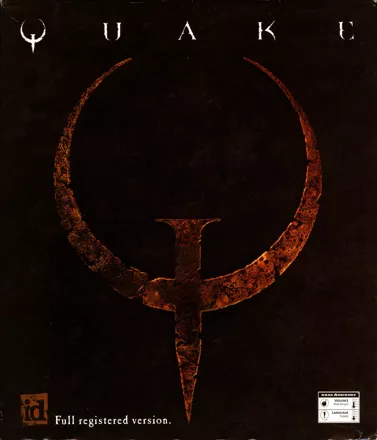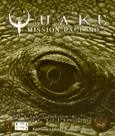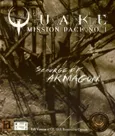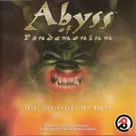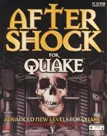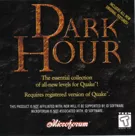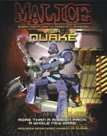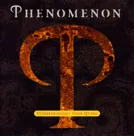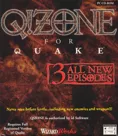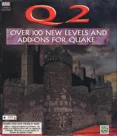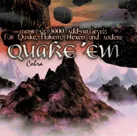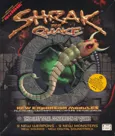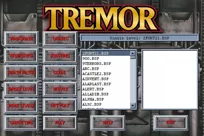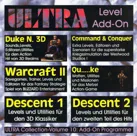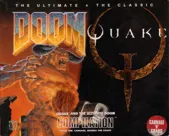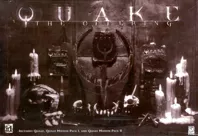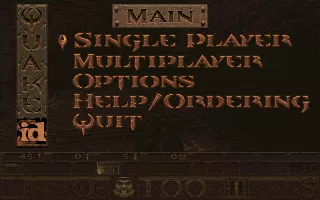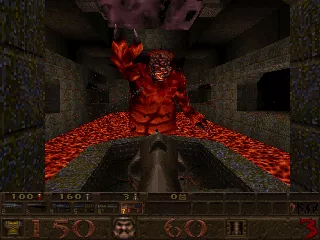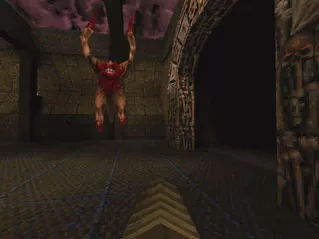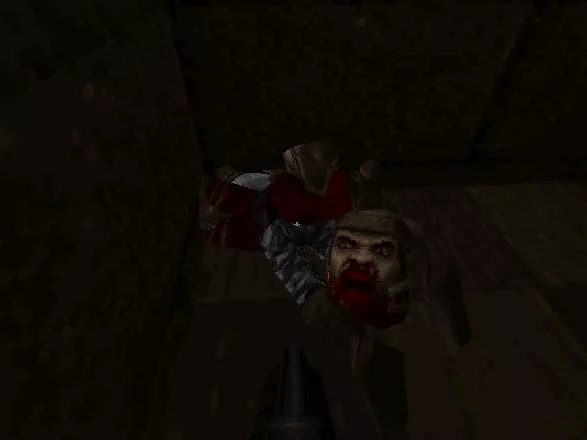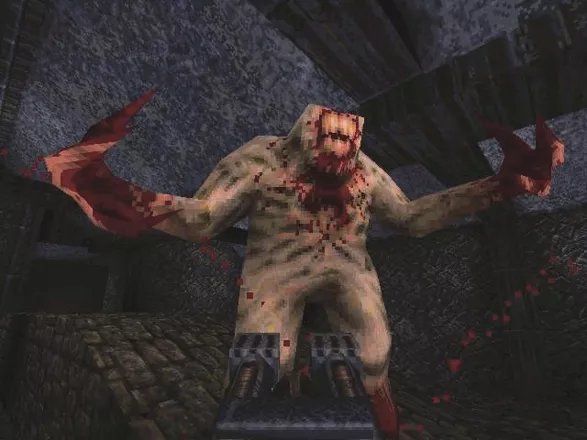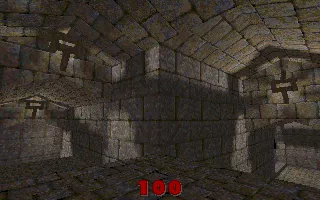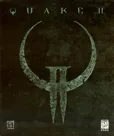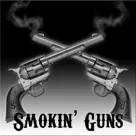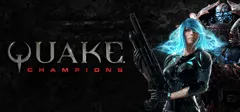Quake
-
 Quake
(2021 on
Windows,
Windows Apps,
PlayStation 4...)
Quake
(2021 on
Windows,
Windows Apps,
PlayStation 4...)
Description official descriptions
An enemy with the codename ''Quake'', which is believed to come from another dimension, is using teleporter gates to invade Earth. The player takes the role of a nameless soldier who arrives at his base only to find out Quake has overrun it and killed everyone. Somewhere in the base, there must be a teleporter to Quake's realm. The mission is clear: take the fight to the enemy, overcome countless hordes of monsters, and exact revenge.
id Software's follow-up to Doom and Doom II, Quake is a first-person shooter. Its main technological innovation is the use of a true 3D engine - the levels themselves, as well as the enemies, are polygonal. This not only allows for more natural level-designs and character animations, but also for more realistic lighting and the inclusion of simulated physics that have an effect on gameplay: grenades can bounce off walls and around corners, for example.
In single-player mode, gameplay consists mainly of proceeding through the levels (spread over four distinct episodes) in search of an exit, killing everything that moves. Interaction with the game world is reduced to a minimum: since there is no use key, buttons are pressed by running into or shooting at them. As in id's earlier games, many secrets are waiting to be discovered, including a few hidden levels.
Unlike Doom's rather straightforward design that couples futuristic environments with demonic imagery, the theme of Quake's levels, enemies, and weapons is not so easily pinpointed. While each episode begins in a futuristic military base (with a technological 'slipgate' as the level exit), later levels take place in environments inspired by medieval fantasy and gothic horror (castles, dungeons, and caverns) and the player passes through magical portals to advance. In a departure from Doom's colorful environments, all Quake levels are dominated by earth colors.
The enemies conform to the mishmash of designs: there are human opponents armed with shotguns and energy weapons in the early levels, while the later levels include medieval knights, ghosts, zombies, ogres (armed with grenade launchers and chainsaws), and some more unearthly beasts. The player's weapons, while relatively modern, all have a low-tech feel. Besides a (bloodstained) axe, there are shotguns, nailguns, rocket and grenade launchers, and the Thunderbolt, which discharges electrical energy.
Quake was one of the first games playable natively over the Internet in addition to LANs. The single-player levels can be played cooperatively, but the game is most famous for its deathmatch mode. One-on-one duels, team play, and free-for-all competition are possible. The emphasis is on fast reaction and skillful maneuvering through the levels. All of the single-player maps can be used as arenas, but the game also comes with six maps specially designed for deathmatch.
Spellings
- 雷神之锤 - Simplified Chinese spelling
Groups +
- 3D Engine: Quake
- 3D Engine: SlaveDriver
- BPjS / BPjM indexed games
- Game feature: In-game screenshot capture
- Gameplay feature: Drowning
- Gameplay feature: Recordable replays
- Games with Dopefish
- Games with officially released source code
- Inspiration: Author - H. P. Lovecraft
- Online Service: Heat.net
- Quake series
- Replay (GT / Infogrames / Atari) releases
- Total Entertainment Network (TEN) multiplay platform
Screenshots
Promos
Videos
Add Trailer or Gameplay Video +1 point
See any errors or missing info for this game?
You can submit a correction, contribute trivia, add to a game group, add a related site or alternate title.
Credits (DOS version)
27 People (15 developers, 12 thanks) · View all
| Programming | |
| Tools Programmer | |
| Level / Scenario Design | |
| Music | |
| Sound | |
| Project Manager | |
| Support | |
| Biz | |
| Biz assist | |
| Special Thanks To | |
| [ full credits ] | |
Reviews
Critics
Average score: 87% (based on 61 ratings)
Players
Average score: 4.0 out of 5 (based on 465 ratings with 19 reviews)
A completely underrated yet revolutionary game.
The Good
My God, John Carmack - what more is there to say? While completely underrated (for some reason), this game was simply revolutionary at the time. Unlike Doom it came with a completely, 100% true 3D engine with gouraud-shaded textures and it ran DAMN FAST on any Pentium and adequately on an old 486.
This game completely revolutionized the genre: it was the first to come out-of-the-box with TCP/IP support for internet play (not through TEN or other such services) -- if you had the bandwidth to spare you could simply set up a Quake server and get it on! It was also the first to use the now-common server/client architecture (push the Tilde key and you'll see what I mean) and the first one which doesn't require a seperate module (COMMIT) for multiplayer play.
And most importantly, this game is damn challenging and fun in single player and multiplayer alike!
The Bad
It looks a bit on the brownish side, but we'll let that one pass. The sound effects are a bit annoying too.
The Bottom Line
A wonderful, underrated classic which didn't get the attention it deserved.
DOS · by Tomer Gabel (4538) · 2000
Couldn't live up to the enormous hype.
The Good
Quake was a marvelous tech demo. The graphics were true 3D, and the multiplayer component was (apparently, I really don't know firsthand) revolutionary in its day, as one could easily hop on and find opponents through that direct TCP/IP thingie everyone was ooohhing and ahhhing over.
The Bad
The single player game just wasn't all that compelling after the intense, Mars-meets-Hell action of Doom and Doom II. Plus, Quake set a new low bar for storytelling--there is no story, period. I haven't really played multiplayer Quake, and the idea of trigger-happy FPS fragging online just hasn't ever appealled to me, so I can't bury or praise Quake on that score.
The graphics are not now, nor were they ever, as impressive as they were alleged to be. YES, it was true 3D and used polygons instead of sprites, but that doesn't mean it was pretty to look at. The bad guys tend to look polygonal, which just doesn't cut it for me; I'll take good-looking sprites over jagged blobs any day. Not to mention how utterly BROWN the whole thing is…ick!
Quake's claim to greatness has to be that it paved the way for later games that were both technically brilliant AND aesthetically pleasing. Sorry Mr. Romero, but I just don't think design was law in this case.
The Bottom Line
Quake was a fabulous tech demo, but only a decent game. A "classic" in its brief heyday, it's just "ok" now.
DOS · by PCGamer77 (3158) · 2002
The Good
When Quake came out in 1996, it's technology was simply amazing. 100 percent true 3d in a fast action game was something never accomplished before Quake, so you can imagine the impact it had.
The gameplay was very much like Doom's, except there were some more bits and pieces incorporated into the levels (for example, hidden shootable buttons that were mostly located in dark areas) to add a little puzzle aspect to them. The levels were large and nicely designed, however the textures looked a little ugly when you where in close proximity to them. The soundtrack, which was contributed by Nine Inch Nails (Trent Reznor), was very atmospheric and scary, it contributed a lot to the overall atmosphere of the game (you need to get the CD-ROM release to get it, it is not included in the downloadable version sold by id -- it's a must have!).
The multiplayer was simply astounding when this came out. It was also the first id fps to support internet play out-of-the-box (Doom did not originally support this because the internet was not much used in 1993).
The Bad
There aren't much things not to like about Quake, since there's not that much to it. However, every game has it's faults (well, I'm pretty sure about that anyway), so here are Quake's few.
First of all, the colors. This is a matter of taste of course, but there have been many complaints by gamers in the past about the 'brown' look of the game (lack of variation in color). Look at the screenshots to see what I mean.
Second, little replay value. It's still fun the second (or third) time, but the 'scare' factor will be gone for the most part.
Third, the end game is just bizarre. It sucks, one of the worst endings ever.
Also, some of the levels were plain stupid. But only a handful, and I personally think the good far outweighs the bad in this case.
The Bottom Line
Quake is a great game if you like the kind of first person shooter that doesn't go into too much detail about 'why', 'where', or 'who'. I've still got it installed on my P90 to this day and I get back to it time by time. Quake remains enjoyable even after ten years of aging.
DOS · by PimPamPet (91) · 2006
Discussion
| Subject | By | Date |
|---|---|---|
| Paul Steed credit | leilei (343) | Aug 13, 2012 |
| What music? | null-geodesic (106) | Jun 12, 2008 |
Trivia
1001 Video Games
The PC version of Quake appears in the book 1001 Video Games You Must Play Before You Die by General Editor Tony Mott.
Scrapped versions
The Game Boy Advance version of Quake was in development by AGB Games. There were also plans for port to Sony PlayStation by Lobotomy Software, which was able to work, under some circumstances, in 60 FPS. First one was cancelled for unknown reasons, while second cancellation was caused by fact, that developer failed to find a publisher.
3D cards support
The original game had software rendering mode only. You could download glquake to use your 3d accelerated card. A special version was made for the intergraph rendition cards called vquake.
Anaconda level
Bizarre product tie-ins: for the release of the movie Anaconda, Sony pictures released through their website an add-on level for Quake titled Temple of the Mist were you made your way trough an ancient temple searching for the altar that holds the key to escape. Obviously, before escaping you have to go mano a mano with the Anaconda itself...weird uh?
Development
The original Quake was supposed to have a medieval environment, but a few months before its release, most of the medieval-role playing aspects of the game were removed (i.e. one of the weapons was going to be a sword and there was a dragon to fight with) and the result was a game with guns but such enemies like the fiend or the death knight (these were included in the original project). Many original design elements were scrapped -- the kernel idea behind Quake was this massive Thor-like warhammer that you could slam down on the ground to make shockwaves ripple through the game world. This "ultimate weapon" idea followed John Romero to his game Daikatana.
The original concept was inspired by a character named Quake in id's long D&D campaign (which actually ended with demons destroying the universe due to John Romero's greed), DM'd by John Carmack. Because of the switch to sci-fi, Romero was angry enough to leave id after Quake, even though Carmack fired him first. He later used another inspiration from the D&D campaign to make Daikatana.
Deathmatch
Kornelia, a famous female Quake player, won the "TEN GibFest Contest" at the computer game developers conference at Santa Clara. As a result, she was afforded the opportunity to play John Romero in a 1v1 deathmatch. She beat him 22 to 1 and also took home a P200 MMX system.
Dopefish
Quake is yet another of id Software's games that contains the infamous Dopefish. The level you can find the Dopefish on is E2M3, The Well of Wishes, in a secret location that you'd probably need a walkthrough to get to. Incidentally, "The Well of Wishes" is the same title as a Commander Keen 4: Secret of the Oracle level where the Dopefish first appears.
Engine
The engine that iD Software started to make Quake with was called Six Degrees of Freedom
German index
On August 31, 1996, Quake was put on the infamous German index by the BPjS. For more information about what this means and to see a list of games sharing the same fate, take a look here: BPjS/BPjM indexed games.
IFQuake
Taking John Romero's work on the Apple ][ bootloader for Infocom's Zork Zero as a point of departure, in 2004 Jason Bergman released IFQuake -- the difficulty-selection stage and first level of the shareware version of Quake implemented as a text adventure game, downloadable at http://mirror.ifarchive.org/if-archive/games/zcode/ifquake.zip
Innovations
Almost incidentally, Quake introduced the now-standard concept of a FPS 'console', and popularised 'mouselook' as *the* absolute standard control interface. Although the specifications required a Pentium, Quake ran acceptably well on a 486 DX4/100 and, at a push, the faster 486es. Along with Magic Carpet it was however the game that most established the Pentium as a must-have processor. It was also the first game which offered the opportunity for both Amiga and PC gamers to play online together.
Machinima
Machinima, an animated film using the 3D environment of a game, started with the Quake engine. Doom already had a recording feature, but it wasn't until Quake when people added narrative and called it "movies" that the genre was born. The first known machinima is Diary of a Camper, by a group of players called The Rangers, released on October 26, 1996.
Qtest1
Quake was preceded by Qtest1, a tech demo which was released in February 1996. It consisted of three small, monster-free levels which illustrated the game's engine. Of particular note was Test3, which became the basis for the second level of Quake's first episode (of the other levels, Test2 seemed to be a very, very early incarnation of 'Ziggurat Vertigo', the infamous low-gravity secret level). The engine was almost fully complete, although wall-mounted torches were still sprite-based.
Although the test had no game - rather like the original Doom 'alpha releases' - multiplayer support was, fortunately, included. The infamous 'rocket jump' was discovered quite quickly, as Qtest included both rocket and grenade launchers.
"Chris ([email protected])" eventually discovered that monsters were included in the game's source code, and a patch released in June 1996 allowed players to experience early versions of Quake's beasties.
References
All of the sounds and music for Quake were produced by Trent Reznor, the man behind the industrial/alternative group Nine Inch Nails. The ammo boxes for the nailgun ("nails") have the band's logo (NIN) on the side.
References to the game
One of the songs on Karl Sander's album Saurian Meditation, "Elder God Shrine", was named after the Quake level E4M3 which has the same name.
Saturn version
The Saturn version of Quakeis the only version with coloured lighting, something Lobotomy Software added to the saturn version
Source code release
In 1999, id Software made the complete source code for Quake freely available to the public. You can download it here.
Speedruns
Quake inspired the art of speedruns: trying to beat a game as fast as possible. The initial release was Quake Done Quick, completed in 19:49 and released on 1997. As of 2012, players still work on breaking the latest records.
Zeeboo version
On June 15, 2010, both Quake and Quake II were removed from Zeebo's wireless network, the Brazilian Zeebonet. Both games were offered for 10 Z-credits and each Brazilian Zeebo came with 35 Z-credits, so the games were sold virtually for free. They were replaced for Zeebo Extreme Rolimã and Zeebo Extreme Jetboard as free downloads.
Awards
- Computer Gaming World
- November 1996 (15th anniversary issue) - #36 in the “150 Best Games of All Time” list
- November 1996 (15th anniversary issue) – The Best Way To Die In Computer Gaming (being telefragged)
- November 1996 (15th anniversary issue) –Worst Back Story of All Time
- November 1996 (15th anniversary issue) – #5 Least Rewarding Ending of All Time
- May 1997 (Issue #154) – Action Game of the Year
- May 1997 (Issue #154) – Action Game of the Year (Readers' Choice)
- May 1997 (Issue #154) – Special Award for Technological Achievement (for its engine)
- April 1999 (Issue #177) - Introduced into the Hall of Fame
- March 2001 (Issue #200) - #8 Best Game of All Time
- GameSpy
- 2001 – #5 Top Game of All Time
- GameStar (Germany)
- Issue 12/1999 - #7 in the "100 Most Important PC Games of the Nineties" ranking
- PC Gamer
- April 2000 - #14 in the "All-Time Top 50 Games" poll
- April 2005 - #26 in the "50 Best Games of All Time" list
- Power Play
- Issue 02/1997 – Best Multiplayer Game in 1996 (together with Jagged Alliance: Deadly Games)
- Świat Gier Komputerowych
- February 1997 (Issue #50) – readers' award Hitek'96 for the best foreign game of 1996
Information also contributed by Adam Baratz, Ashley Pomerov, chirinea, Darksaviour69, D Michael, Erkan O; keth, Maw, n-n, PCGamer77, Pseudo_Intellectual; Sciere, Scott Monster, Xoleras, Zack Green and Zovni
Analytics
Upgrade to MobyPro to view research rankings!
Related Sites +
-
FitzQuake
The most faithful custom engine available. -
Func_Msgboard
An ever-active forum dedicated to custom mapping, primarily focusing on the original game but also covering the following games in the series from time to time. -
Matt Chat 54
Video interview with John Romero about the development of Quake -
Planet Quake
An exhaustive quake site visit it for news, mods, levels, tips and all you want related to Quake -
Quaddicted
The most comprehensive site for custom singleplayer maps. -
Quake
Official page on id Software's website -
Quake cheat codes
Detailed information on Quake 1 cheat codes for N64, PC and Sega Saturn -
Tenebrae
Tenebrae is a modification of the quake source that adds stencil shadows and per pixel lights to quake. Stencil shadows allow for realistic shadow effects on every object in the game world. Per pixel lighting allows you to have fine surface details correctly lit. These are essentially the same algorithms as used by the new Doom game.
Identifiers +
Contribute
Are you familiar with this game? Help document and preserve this entry in video game history! If your contribution is approved, you will earn points and be credited as a contributor.
Contributors to this Entry
Game added by robotriot.
Zeebo added by chirinea. Nintendo 64 added by Kartanym. Amiga, Windows Mobile, Acorn 32-bit added by Kabushi. Windows added by The cranky hermit. Macintosh added by Ace of Sevens. SEGA Saturn added by quizzley7.
Additional contributors: JubalHarshaw, Andrew Hartnett, Ledmeister, Roedie, Unicorn Lynx, Atomic Punch!, erc, Kabushi, Patrick Bregger, Titan10, Karsa Orlong, MrFlibble, FatherJack, R3dn3ck3r.
Game added November 3, 1999. Last modified March 6, 2024.
